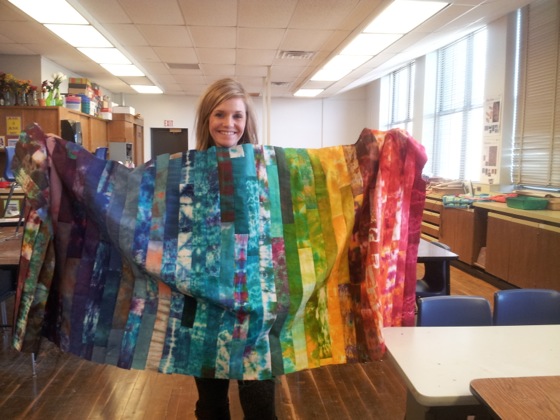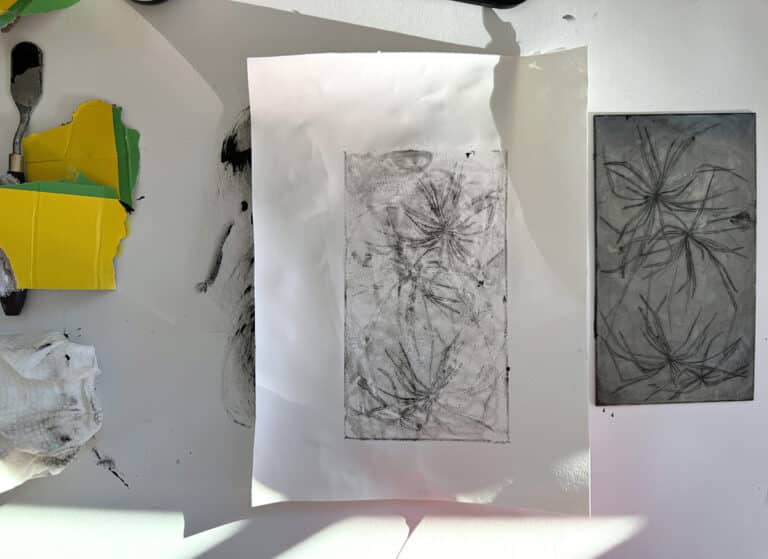Batik is the art of using wax resist and dye to decorate fabric. The art of batik has been practiced for centuries all over in the world, predominately in Asia and Africa. Including a batik lesson in your art curriculum allows you to teach the history of batik specific to a region of your choice. The beauty of teaching batik is the cross curricular connections. The downside is that batik can be intimidating. I understand that the thought of using hot wax and permanent dyes with students can be terrifying and possibly out of the question. Rest assured, it is possible to incorporate soy wax batik in your curriculum with some education, preparation, organization, and planning. Today I’ll share my experience with batik in my classroom as well as amazing resources you can use to get started in yours!

My love and fascination with batik started a couple of years ago, after I participated in a fine arts class at a local arts guild. The professor had extensive experience with fabric dyeing and taught us how to create batik using soy wax instead of the traditional batik method using beeswax. The advantage of using soy wax over beeswax is that soy is less toxic and easier to remove because it’s washable.
I suggest you start small when teaching fabric dyeing for the first time. I introduced it to my students in an after school art class of 15 students in grades 6th through 8th. I provided each student with 12, 3″x14″ pieces of fabric and a silk scarf. Students practiced different dyeing techniques on the 3″x14″ pieces. The last dyeing technique I demonstrated was batik. Students then created batik scarves.
A grandparent volunteer generously offered to sew a quilt with the dyed fabric pieces. This is the finished piece.

If you’re looking to do batik in your classroom, but feel overwhelmed, consider starting with the following three steps.
1. Research Fabric Dyeing
Whether or not you take an official class, it’s a good idea to research the fabric dyeing process. I recommend reading about dyes through the Dharma Trading Company. You can also find a lot of great video resources on YouTube.
2. Brush Up On Your Batik Skills
I took a weekend workshop which helped me learn how to batik. If a local class isn’t available, you can register for an online fabric dyeing class such as “The Art of Cloth Dyeing” with Jane Dunnewold. Like any new technique, it’s important that you are comfortable with the process and have some experience before you teach it to your students, especially when that process involves hot wax and permanent dyes.
3. Gather Your Materials
In order to do Batik in the classroom, you will need the following items:
- fiber reactive procion dyes
- soy wax
- fabric
- plastic gloves
- an electric frying pan or small crock pot for melting wax
- plastic for covering tables
- cardboard scraps for placing fabric on top when dyeing
- printing materials (rubber bands, paint brushes, metal items, sponges, etc…)
- plastic wrap for wrapping dyed fabric while it sets
- hot water and soap for the rinsing process
- newspaper or newsprint and an iron for getting out the remaining wax left on the fabric
Here are some additional resources and references to get you started!
If you’re looking for more information about the history of batik, check out The Batik Guild.
To purchase batik supplies and learn more about the process, visit Dharma Trading Company.
For another simple batik tutorial, head on over to the blog sew sew art.
For more information about safety, read this handout from Pro Chemical & Dye
Of course if the traditional method of batik isn’t the best fit for your classroom, you can teach batik using paper and oil pastels or crayons.
Have you ever taught batik in your classroom? I’d love to hear any tips you have to share!
Magazine articles and podcasts are opinions of professional education contributors and do not necessarily represent the position of the Art of Education University (AOEU) or its academic offerings. Contributors use terms in the way they are most often talked about in the scope of their educational experiences.




